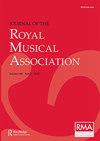Scaramouche, Scaramouche: Sibelius on Stage
IF 0.5
2区 艺术学
0 MUSIC
引用次数: 0
Abstract
Abstract Sibelius’s only balletic pantomime, Scaramouche, composed in 1913, remains one of his least-known works, even though it is one of his longest dramatic scores and belongs to his period of compositional re-evaluation. This article explores the pantomime in the context of its first production, performed in 1922 in Denmark and 1924 in Sweden. It argues that the pantomime’s reception both illuminates the importance of dance as a formative ‘modern’ genre within the Nordic countries during this period, and demonstrates that the score is defined by stylistic plurality, which was key to its theatrical success. The article calls for increased musicological attention to Nordic theatrical music, a genre that was extremely popular among early twentieth-century Nordic composers. It provided musicians with musical spaces that were more liberating than the concert hall or the opera house for the purposes of cultivating their musical language.Scaramouche, Scaramouche:舞台上的西贝柳斯
摘要西贝柳斯唯一的芭蕾哑剧《Scaramuche》创作于1913年,仍然是他最不为人所知的作品之一,尽管这是他最长的戏剧作品之一,属于他重新评估作曲的时期。本文从1922年在丹麦和1924年在瑞典上演的第一部哑剧的背景下探讨了这部哑剧。它认为,哑剧的受欢迎程度既说明了舞蹈作为这一时期北欧国家形成性“现代”流派的重要性,也表明了风格多样性是其戏剧成功的关键。这篇文章呼吁在音乐学上更多地关注北欧戏剧音乐,这一流派在20世纪初的北欧作曲家中非常流行。它为音乐家提供了比音乐厅或歌剧院更自由的音乐空间,以培养他们的音乐语言。
本文章由计算机程序翻译,如有差异,请以英文原文为准。
求助全文
约1分钟内获得全文
求助全文
来源期刊
CiteScore
0.50
自引率
0.00%
发文量
16
期刊介绍:
The Journal of the Royal Musical Association was established in 1986 (replacing the Association"s Proceedings) and is now one of the major international refereed journals in its field. Its editorial policy is to publish outstanding articles in fields ranging from historical and critical musicology to theory and analysis, ethnomusicology, and popular music studies. The journal works to disseminate knowledge across the discipline and communicate specialist perspectives to a broad readership, while maintaining the highest scholarly standards.

 求助内容:
求助内容: 应助结果提醒方式:
应助结果提醒方式:


